Share Your Network Connection with Hyper-V in Windows 10

Previously, we showed you how to use Hyper-V, available in Windows 10 Pro only. here’s how to set up a virtual machine with another copy of Windows.
Previously, we showed you how to use Hyper-V, available in Windows 10 Pro only, to set up a virtual machine with another copy of Windows. I recently needed to perform some testing but realized I would need the Internet for this to work. Unfortunately, Hyper-V’s out of box networking support is not really intuitive. It can be done but is a bit involved. To share your computer’s Internet connection with a Hyper-V virtual machine, you will need to set up a virtual switch through your Internet connection. In this article, we show you how to do it.
Share Your Network Connection with a Hyper-V Virtual Machine
If you don’t have already have a virtual machine setup, check out our previous article for instructions. If you already do, proceed to launch the Hyper-V manager. Select your virtual machine, then click Virtual Switch Manager under the Actions pane.
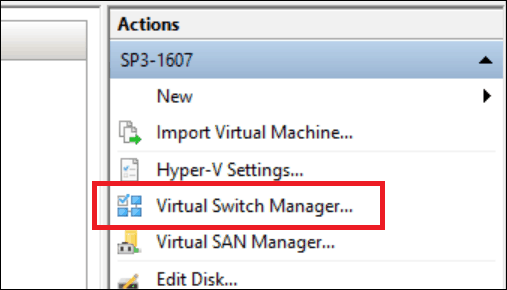

Select New virtual network switch, select Internal, then click Create virtual switch.
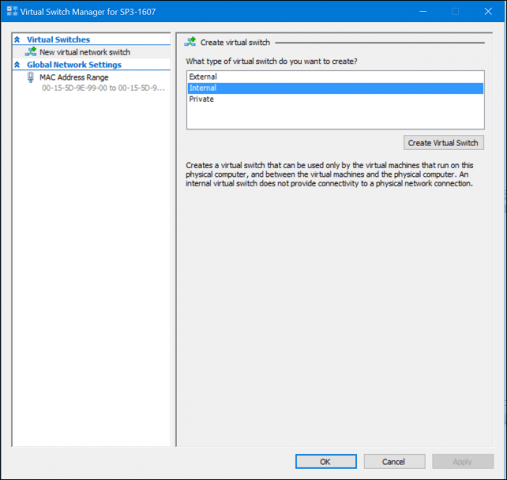

Enter a name for your switch, then select Internal Network. Click Apply then OK.


Select your virtual machine, then click Settings under the Actions pane.


Select the Add Hardware tab; select Legacy Network Adapter, then click Add.
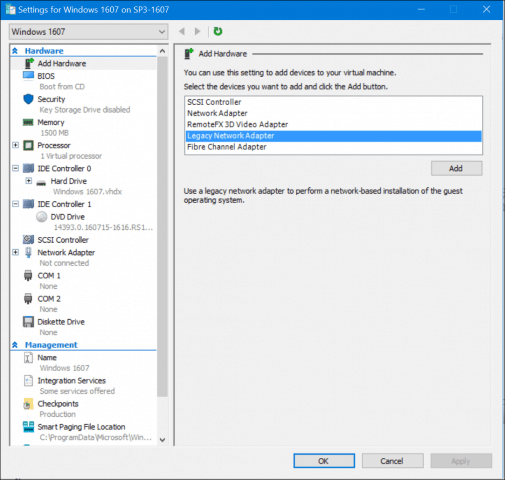

Click on the Virtual switch list box, then select the connection created earlier; mine is Groovy Connect. Click Apply then OK.


Right-click the network icon in the connection icon in the Notification area, then click Network and Sharing Center. There you will see your newly created connection.


In the same window, click Change Adapter Settings, select your network connection through which your computer connects to the Internet. Right-click the connection, click Properties, select the Sharing tab, then check the box All other network users to connect through this computers Internet connection.
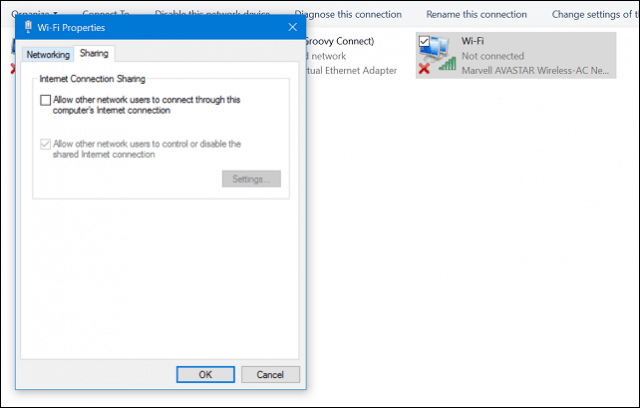

You should now have the Internet set up in your virtual machine. This works whether you are using a wired or wireless connection.
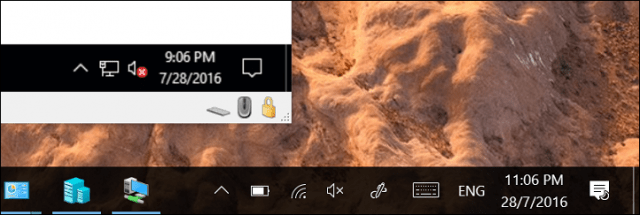

If you run another edition such as Windows 10 Home, you can use a third-party virtual machine utility such as Oracle VirtualBox. VirtualBox handles the networking part of configuring and sharing Internet connections much easier.
21 Comments
Leave a Reply
Leave a Reply







Laurence Frishman
August 11, 2016 at 11:26 am
What’s a virtual machine and what’s it for?
Andre Da Costa
August 12, 2016 at 10:13 pm
A virtual machine is a non-physical guest running within another computer using specialized software that allocates some of the hardware resources of your physical machine. You can use it to run applications that might not be compatible with the OS running on the physical machine.
For example, if I have older app that works only on Windows 7, I can install Windows 7 in a virtual machine and run it on top of Windows 10 at the same time.
L
February 23, 2017 at 9:49 am
Legacy doesn’t show up in the Virtual Switch options…
L
February 23, 2017 at 9:52 am
Also I have to select another switch after checking “allow other network users…”
Tony
March 24, 2017 at 2:49 pm
I have the same problem. This will not work,
Tim M
March 26, 2017 at 12:52 am
I got it to work. Tried everything and as soon as I picked a NIC it lost connection. I uninstalled Hyper-V, re-installed it and tried again and it worked. You might try that.
Tim M
March 1, 2017 at 10:55 am
followed this to the letter, still no connection on the virtual switch.
William
March 30, 2017 at 5:25 am
Thanks Andre, it worked for me !
Martine
April 15, 2017 at 6:52 pm
This worked beautifully thank you!
John
March 29, 2020 at 1:27 am
I’m using the latest and there is no virtual switch manage under Action. What are you talking about here?
Urga B
July 8, 2017 at 10:26 pm
Thanks a lot. It was a perfect solution. Now I can browse from the guest os.
Simon Potter
August 24, 2017 at 12:32 am
I can’t tell you how incredibly helpful this article was! On my laptop hyper-v is probably 10x faster than Virtualbox but without wifi it was basically useless. Thanks a lot for providing so much detail, it works perfectly for me, this has been the missing link on hyper-v for me it will save me hours of waiting time.
Chad Hedstrom
August 24, 2017 at 7:28 pm
FYI you need to run a Gen 1 VM, Gen 2 does not have legacy network adapter
Tyler
November 16, 2017 at 6:05 am
Thank you very much for posting this!
I was still having trouble even after following these steps though.
I kept poking around and found out that I didn’t have the setting to make my VM Discover-able by my network, duh!
Dustin
November 17, 2017 at 8:00 pm
Why are you using an internal switch rather than an external switch if you want to get out to the internet? Why did you use the legacy adapter option rather than adding a standard network adapter already on your system?
Etai
November 30, 2018 at 8:11 am
It works fine for me but after a few days the internet connection is down.
I re-do the entire process and it works again.
anyone know why does the connection keeps breaking?
Raymond
April 17, 2019 at 11:24 am
In the latest version, if you have Default Switch, you don’t have to create any new virtual network switch.
All you need to is set your VM instance using Default Switch.
Nicola
August 30, 2019 at 2:18 am
When I click Change Adapter Settings and select my network connection through which my computer connects to the Internet and Right-click the connection and click Properties and select the Sharing tab, the box All other network users to connect through this computers Internet connection is not there but just “Internet Connection Sharing has been disabled by the Network Administrator” so I don’t know what to do at this stage maybe asking for an authorization by my Working Institution / Network Administrator?
Kouadjo Bini
October 24, 2019 at 3:17 pm
This Works Great ! thank you so much
Edgar
February 18, 2020 at 11:57 pm
i use the Microsoft hypervisor to run OpenSuSE Linux in a virtual machine on my Dell laptop running Windows 10. The procedure described in this article works great, until the first time I reboot my laptop. I’m assuming that there is a setting that is not surviving the reboot, but instead is being reset. So far, I’m not finding anything obvious.
FarTue
October 13, 2021 at 8:31 pm
All I wanted to do was quickly fire up a DietPi VM in my home Windows server.. Installing the Hyper-V support? Piece of cake. Creating a new Hper-V of DietPi? Dead easy. But network connection always shows “Not connected”. 2 hours of hair pulling later I stumble upon your page with the KEY piece of information : need to go to network and sharing to enable sharing of the physical adaptor. This is not documented in Microsofts software. Thanks Andre.